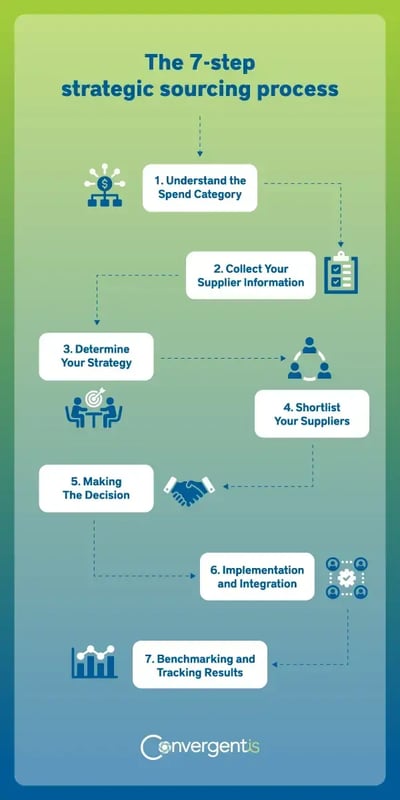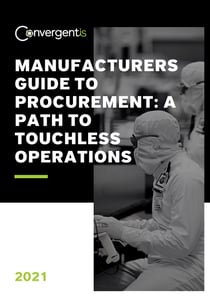 As markets become more competitive, many procurement teams seek new avenues to reduce costs and mitigate risks while still guaranteeing the highest levels of product and service quality. Recognizing the need to maintain this advantage, strategic sourcing has continued to gain in popularity as a method for continuous evaluation and improvement of standard end-to-end procurement practices. Organizations can leverage the resulting data from the strategic sourcing process to create and execute a cohesive plan.
As markets become more competitive, many procurement teams seek new avenues to reduce costs and mitigate risks while still guaranteeing the highest levels of product and service quality. Recognizing the need to maintain this advantage, strategic sourcing has continued to gain in popularity as a method for continuous evaluation and improvement of standard end-to-end procurement practices. Organizations can leverage the resulting data from the strategic sourcing process to create and execute a cohesive plan.
Typically, businesses will follow a 7-step vendor management process designed by A.T.Kearney in 2001. Now a benchmark for the sourcing process, these seven steps must be incorporated within each team's technology layout to ensure steps are being followed and managed with the greatest attention to detail possible.
1. Understand the Spend Category
The first stage is to develop a deep understanding of the spend category. In this step, users will need to understand usage patterns, the users, where they are located, the type and grade of the supplier and processes used. Next, teams must look at the market. The procurement team is tasked with identifying feasible sources for the necessary raw materials.
Consider that for specific resources, there may only be a limited number of suppliers or geographic locations that these resources can be sourced from. Naturally, with narrower options comes less negotiating power and fewer contingency suppliers to engage in the event of a disruption.
2. Collect Your Supplier Information
Following the market analysis, decision-makers must look at the specific vendors themselves. Teams are encouraged to consider how these vendors operate and whether they can meet the needs of your business by issuing a Request for Information (RFI), Request for Quotation (RFQ) or Request for Proposal (RFP). Establish your company's aim and minimum supplier requirements, then make a list of the selection criteria that are most suited to your needs, capabilities, and resources, determining whether it makes sense to conduct a direct purchase (send an RFP) or an RFQ acquisition, purchasing from a desired supplier or engaging in a strategic partnership, where users enter an agreement with a selected supplier.
In some cases, it is recommended that teams organize in-person visits at this stage to ensure that a supplier is compliant with their standards.
3. Determine Your Strategy
Determining where and how to buy while reducing risk and expense is the third important consideration. You should analyze both present and potential vendors to get the most out of your supplier pool.
One of these strategies is positioning your business as an OEM partner. In this relationship, suppliers may provide your team with a component that you can use or insert as part of your product. However, this piece is often integrated without the supplier’s branding.
Alternatively, some businesses will engage with their suppliers as a coprocessor, an arrangement describing a co-selling or co-branding process. Effectively, this is the opposite of the process listed above, since instead, or avoiding your supplier’s branding, the vendor actively promotes it. For example, you may see the phrase, “solution is powered by XYZ.” This relationship is usually apparent in situations when the supplier is providing equal or greater value than the vendor.
The final scenario is described as a value-added reseller (VAR), where you the vendor are only adding a small amount of value on top of the supplied offering.
Keep in mind that while conceptually developing a strategy comes along with basic procurement knowledge, actually tracking an order from RFQ through to delivery often involves several spot solutions. For businesses, this can make it more difficult to follow through on the strategy as specified.
4. Shortlist Your Suppliers
You may now have many providers responding to your RFP. The next step is to shortlist the most promising providers, then interview them for clarification or more information if necessary.
To ensure that shortlisted suppliers are among the top choices, teams need as much information as possible, including historical data about on-time deliveries and the percentage of returns, both of which may indicate a vendor’s quality and reliability.
Developing a supplier shortlist is not a one-time occurrence. Rather, as teams engage with multiple suppliers and begin building up a repertoire of data, the onus is on them to centralize their findings, making it as simple as possible for these insights to be applied in strategy. For example, by consolidating data the team shares across the whole company users can determine the total purchasing amount, enabling vendors to achieve a volume discount.
5. Making The Decision
With a shortlist in hand, teams must then make their decisions. This is often a complicated process which may require conducting multiple rounds of meetings or even an A/B test to determine which teams are providing the best all-around offering. Making the decision will then conclude with a signed contract that has been read and agreed to by both parties. +part of the qualification process, can the supplier actually do this at scale
6. Implementation and Integration
To ensure that suppliers, end-users, and everyone else in the procurement process remain informed, collaboration and implementation become closely intertwined. In the SAP space, technology for building collaborative consumer-grade workspaces, such as SAP Work Zone, comes in handy to help in the facilitation of these conversations. When designed properly, these setups consider how end-users really work. The result is a solution that users are readily willing to adopt since it is easier to use than the disparate tools they have access to currently.
7. Benchmarking and Tracking Results
To determine if your project will be successful, you need a baseline for measurement. Therefore, businesses will often rely on technology to identify if and where a supplier is adding value, such as offering lower-than-market pricing, or higher-than-average quality. While this process can be tedious if teams attempt to do so manually, automated data acquisition and reporting often simplifies the entire supplier relationship management process, to ensure users can easily identify if a target is being met.
Improve Your Strategic Sourcing Process
Our team at ConvergentIS aims to address these seven distinct steps in a single end-to-end procurement solution that helps businesses to ensure strategic sourcing is maintained. Bear in mind that any flaws in this sourcing plan can often turn a profitable process into one that drains your budget.
For these reasons, automated and streamlined solutions that leverage specialized cloud-based software have become popular methods for teams to engage with suppliers globally and customize project requirements as needed.
Learn more by visiting our guide linked below.


